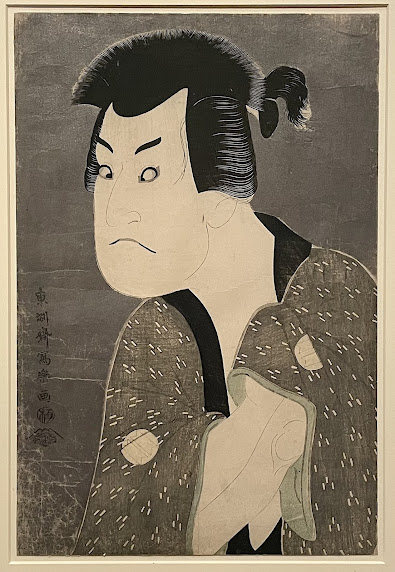I recently visited The Legion of Honor in San Francisco and saw a couple of worthwhile shows – "Japanese Prints in Transition: From the Floating World to the Modern World" (through August 18) and "Woodcut: Primary Printmaking" (through October 20) I'll write more about the latter in a separate post.
The first of these two shows, As its title suggests, is a survey of Ukiyoe with an emphasis on how the medium responded to the very rapid changes that occurred in Japan with the opening of the country after about 250 years of self-imposed isolation and the Meiji Restoration in 1868. Visually, the most obvious change is from the use of natural pigments to the harsh reds, greens, and purples that suddenly appear with the introduction of synthetic aniline dyes. These garish colors became available with the opening of the country in the early 1860s and had become widely used within a decade or two. They were popular because they were inexpensive and vibrant, but I find it hard to avoid feeling that prints using these dyes are mostly inferior to the subtler work of earlier periods, although they are of historical interest. That said, the show has many examples of prints of this period depicting "modern" subjects, which to a large extent meant foreigners and the foreign artifacts and inventions that began to stream into the country along with the aniline dyes. In a complete reversal, the newest prints in the show, by Masami Teraoka (made starting in the 1970s) revert to the more subtle palate typical of the Edo Period, which is being parodied in his work.
The aniline dyes were at least color-fast. An interesting earlier print shows a scene with an odd olive-yellow sky. The accompanying label notes that the sky would originally have been blue, but, printed with a fugitive, naturally-derived pigment made from Asiatic Dayflower (露草 Commelina communisa), the blue has completely faded away.
There are some nice early prints, including two by Sharaku, whose work is scarce, although one of the two is not in very good condition. The best examples of his work I have seen have been in shows in Japan – although not necessarily from Japanese collections. The best-preserved examples of Ukiyo-e of any kind I've seen in Japan have been on loan from the collection of the Boston Museum of Fine Arts.
The Legion of Honor Show includes examples of some of the most recognized Ukiyo-e images – notably The Great Wave, by Hokusai, which has been called the second-most famous work of art in the world after the Mona Lisa. The show also includes two prints that appear in paintings made by Vincent Van Gogh. Also of interest are prints depicting places and events far from Japan that the wall labels point out were known to the print designers only from newspaper reproductions that were coming into the country. Exposure to foreign images is also evident in the way that Western perspective creeps into some of the later prints.
At the end, I was a bit surprised to see that shunga (erotic prints) had been completely neglected until I exited through the inevitable gift shop to see that there was an entire, separate room devoted to these, including top-notch examples by Utamaro and Hokusai.
As noted above, the show continues until this Sunday, August 18. The Legion of Honor is at 100 34th Avenue (at Clement St.), San Francisco, CA 94121, generally open from 9:30 to 5:15, closed on Mondays.











No comments:
Post a Comment